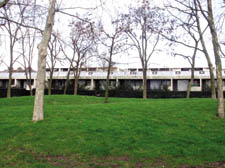|
|
 |
| |

Maiden Lane Estate - Fears that model housing estate is being left to rot |
Tenants count cost of life in ‘masterpiece’
LIVING in a “modern masterpiece” has its drawbacks, as residents on the Maiden Lane estate in Camden Town are discovering.
They fear that an attempt by architectural historians to give the 1970s estate heritage listing status could delay much-needed repairs to homes. The estate was designed by architect Allan Forsyth at a time when Camden Council could claim to be the most pioneering social housing builder in the country.
The Twentieth Century Society, a charity dedicated to the preservation of modern architecture, has called for the estate to be listed so its status as a “masterpiece of the period” can be preserved.
But vital refurbishment work, last estimated at £36 million, has already been put off twice at the estate.
Jon Wright, of the Twentieth Century Society, said: “Maiden Lane is in our opinion under threat. It has had no maintenance since it opened, and comprehensive works will have to be carried out in the near future to repair the badly-weathered windows and public spaces. This will be hugely expensive.
“If Camden were undertaking major works it will be important to ensure those are done sensitively and to a high standard, respecting the architectural quality of Maiden Lane. This can be best achieved through listing.”
He added: “Maiden Lane is a highly sophisticated, incredibly well-executed development which has survived decades of maltreatment and neglect in very good shape. It is the last and arguably most complex of Camden’s ambitious schemes which masterfully combines terraced housing and flats and binds them together with intelligently planned open spaces.”
According to Cantelowes Lib Dem councillor Ben Rawlings, roofs, walls, windows and fittings are all in disrepair.
“Any attempt to get it listed would have to be judged in terms of how it would affect the residents,” he said.
Rob McWilliam, a Maiden Lane resident for 21 years, said: “I’d be in favour of listing but I’d be worried that the costs of what is vital work will rise dramatically.”
He added that the repeated failure to get repairs done had left “a dark cloud over the estate”.
Mr McWilliam said: “I know that if you’ve got a listing on a building, the cost of doing works to it at least doubles, so it could rise to £80 million or £100 million and where is that going to come from?”
His neighbour, Rachel Zatz, a green campaigner, added that listing could threaten environmental projects such as solar panels, green roofs or new trees.
A council press official said: “The estate has a unique design that is architecturally interesting. However, in some areas that design has not stood the test of time.
“We are committed to protecting what is best about the estate, but we need to ensure we can meet Decent Homes standards and maintain good-quality homes in an affordable and sustainable way. Listing can make major renovation works and basic repairs more costly and make it harder to make improvements to the design and layout.”
The press official added that, while the council was lobbying for more direct investment from central government, it needed to consider different ways to raise the money.
A decision on the application to list phase I of the estate – nearest the railway lines – is not expected before April.
|
 |
|
 |
|